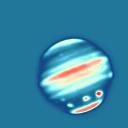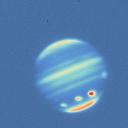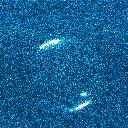The telescope to which the University of Rochester's infrared camera was attached is the Wyoming Infrared Observatory (WIRO), a 92-inch telescope atop the 9,656-foot Jelm mountain near Laramie, Wyoming.
The camera has a 256x256 InSb detector array, and the observations were obtained through a 2 to 2.5 percent CVF (Continuously Variable Filter).
Observations were made by Judy Pipher, Eric Howard, Craig McMurtry, Bill Forrest (U of Rochester), Chick Woodward, Bob Howell, Tracy Hodge (U of Wyoming), and Bob Gehrz (U of Minnesota).


The left image is an image of Jupiter just outside the peak of a methane absorption band. The right image is at 1.7 microns in the peak of the methane absorption band. Notice the contrast of the C, A, and E (left to right) impact sites enhanced in the methane band wrt the reduced intensity of the equatorial region.


These two images were taken out and in another methane absorption band, 2.08 and 2.18 microns respectively.


The left image is at the wavelength of the auroral zones' H[3]+ emission, 3.5 microns. The identification of the E spot emission has not been made. The right image is at 4 microns and the impact sites are not clearly visible.
Here is our second run movie. This is still in its initial stages, so don't expect too much :).
This movie shows Jupiter starting at 4.1 microns and runs down to 1.6 microns (there is a large wavelength gap between 2.2 and 3.0 microns that was not imaged). These images were taken on the night of the 21st (21/22 UT) and are centered near 00 hours UT on the 22nd. The images start above and then go into a methane band in the 3 micron range, where most of the planet (other than the poles and the impact sites) disappears. The movie then jumps to 2.2 microns where the planet is partially in another methane band and continues to show the planet as it comes out of that methane band and then enters another near 1.7 microns. The movie ends at ~1.65 microns.
Here is the latest movie of Jupiter which shows the rotation of the spots. This was done by Brendan Fisher, a former postdoc in our group, using IDL to create the images.
If you want to see some more cool images... Check out the SL9 Homepage out of arizona or click here to see few of the Keck and HST images.